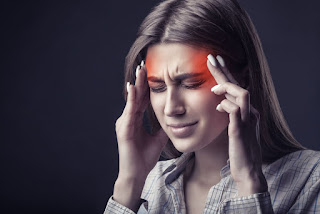What is a migraine?
A migraine is a common neurological disease that causes a variety of symptoms, most notably a throbbing, pulsing headache on one side of your head. Your migraine will likely get worse with physical activity, lights, sounds, or smells. It may last at least four hours or even days. About 12% of Americans have this genetic disorder. Research shows that it’s the sixth most disabling disease in the world.
Migraine symptoms :
Migraine symptoms may begin one to two days before the headache itself. This is known as the prodrome stage. Symptoms during this stage can include:
food cravings
depression
fatigue or low energy
frequent yawning
hyperactivity
irritability
neck stiffness
In migraine with aura, the aura occurs after the prodrome stage. During an aura, you may have problems with your vision, sensation, movement, and speech. Examples of these problems include:
difficulty speaking clearly
feeling a prickling or tingling sensation in your face, arms, or legs
seeing shapes, light flashes, or bright spots
temporarily losing your vision
The next phase is known as the attack phase. This is the most acute or severe of the phases when the actual migraine pain occurs. In some people, this can overlap or occur during an aura. Attack phase symptoms can last anywhere from hours to days. Symptoms of a migraine can vary from person to person. Some symptoms may include:
increased sensitivity to light and sound
nausea
dizziness or feeling faint
pain on one side of your head, either on the left side, right side, front, or back, or in your temples
pulsing and throbbing head pain
vomiting
After the attack phase, a person will often experience the postdrome phase. During this phase, there are usually changes in mood and feelings. These can range from feeling euphoric and extremely happy, to feeling very fatigued and apathetic. A mild, dull headache may persist.
Causes migraine :
A migraine headache is caused by abnormal brain activity. This activity can be triggered by many things. But the exact chain of events remains unclear. Most medical experts believe the attack begins in the brain and involves nerve pathways and chemicals. The changes affect blood flow in the brain and surrounding tissues.
Researchers believe that migraine has a genetic cause. There are also a number of factors that can trigger a migraine. These factors vary from person to person, and they include
Stress
Anxiety
Hormonal changes in women
Bright or flashing lights
Loud noises
Strong smells
Medicines
Too much or not enough sleep
Sudden changes in weather or environment
Overexertion (too much physical activity)
Tobacco
Caffeine or caffeine withdrawal
Skipped meals
Medication overuse (taking medicine for migraines too often)
Risk factors :
Anyone can develop migraine, but it is more common in people with any of the following:
depression
bipolar disorder
fibromyalgia
irritable bowel syndrome
an overactive bladder
sleep disorders
obsessive-compulsive disorder
anxiety.

